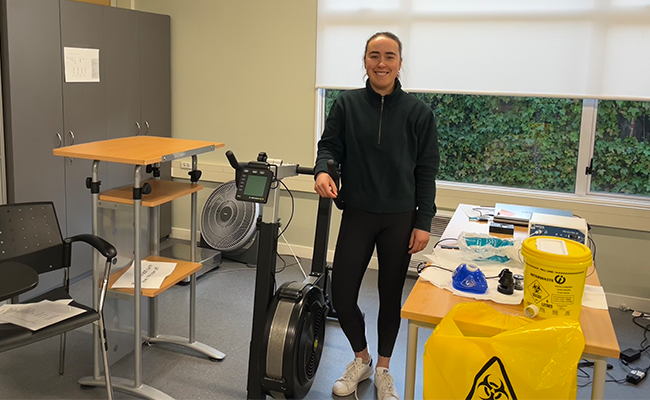Tuesday 21 June 2022 2:11pm

Michaela in the lab next to one of the exercise bikes her study participants use.
Ever wondered whether you sweat differently during your menstrual cycle?
No? Well Master of Science in Human Nutrition student Michaela Rogan is doing the thinking for you.
The University of Otago post-graduate student is conducting research into what impact the menstrual cycle has on a female’s level of hydration during athletic performance.
A ‘logistically challenging’ topic to study, the findings could be hugely beneficial for female athletes, Michaela says.
Liking the idea of researching a project that focused on female health and sports nutrition, she and her supervisor, Associate Professor Katherine Black, came up with the topic together.
Not much research has been done into the menstrual cycle and its effects on female athlete performance, Michaela says.
“On the whole females are pretty understudied in sports nutrition.”
A lot of research has been done on university-aged males weighing 70kg, in part because they are easy to recruit. It is then assumed the findings on those men will apply to women, as well “maybe adjust for weight and lower the recommendations a little bit”.
“But now we’re obviously realising the menstrual cycle has effects on nutrition and sport performance, and it’s not well understood.”
For her pilot study she is aiming to study 12 females, she had recruited them, but COVID-19 has disrupted the process somewhat, meaning some recruits may not complete the study.
They needed to be aged between 18 and 45, have a regular menstrual cycle, not be perimenopausal or postmenopausal, and cannot be on hormonal contraception or have taken any hormonal contraception in the previous three months.
All this makes recruitment of subjects logistically challenging.
Her recruits keep a three-day diet record at a point during each phase of their menstrual cycle, from the follicular phase to luteal phase.
On one of the three days they come in and do a one-hour time trial on the bike in the gym.
Michaela places sweat patches on each participant, measures fluid intake, and calculates sweat rates and electrolyte balance.
The amount of sweat produced will provide valuable information, she says.
Her work can be “pretty frustrating” at times.
“On the whole females are pretty understudied in sports nutrition.”
Because it is an expensive process, the hormone samples collected from blood during a finger prick at the conclusion of each exercise session will only be analysed once all the exercise trials are finished. This means she does not know until she gets the results back whether the data is usable.
Studying the menstrual cycle is “incredibly difficult and not predictable” for other reasons as well, she says.
“Even if you have a normal menstrual cycle, it doesn’t guarantee you’ve regular hormonal fluctuations. So even though we’ve recruited these people, some of them might not ovulate. You need to make sure you have regular (menstrual) cycling females.”
When it came to working with female athletes, it would be important to know if hydration or dietary intakes were varying at different menstrual phases.
“There may be additional considerations for sweat rates, certain nutrition practices, fuelling and hydration might become more important or need to be altered in differ phases of menstrual cycle.
“If you’re really looking or those marginal gains in performance, which we quite often are in athletic context, it could be important.”
What existing research did suggest was as the field of menstrual cycle research grows, there seems to be a lot of variability between individuals.
“Some people respond differently to hormonal fluctuations than others, some feel absolutely no difference in any measures across different phases of the menstrual cycle, other people do.”
This suggested changes to hydration levels and diet would need to be tailored to the individual.
Kōrero by Koren Allpress, Internal Communications Adviser
